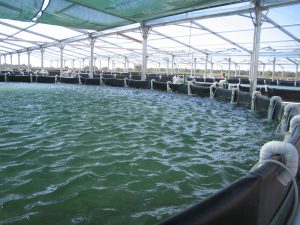Ammonia Reduction Technologies
Ammonia Reduction Technologies zeolite is not only capable of removing ammonia from wastewaters, it can also be reused time and time again.
Natural Zeolite - Ammonia Reduction Technologies


Surface water, ground water, and wastewater contain many pollutants, including inorganic and organic compounds, that are hazardous to humans, animals, and plants. One of the most potent pollutants is ammonia because it contributes to accelerated eutrophication of lakes and rivers, dissolved oxygen depletion, and fish toxicity (Wang & Peng, 2010). Hundreds of studies have examined how zeolite application can remove ammonia through adsorption. Findings suggest that ion exchange, particularly the adsorption of ammonium ions onto the surface of natural zeolites, contributes to its success in ammonia reduction technologies. Ammonia is ammonia nitrogen in water, not nitrate ammonia.
Scientists have also found that the exhaustion and regeneration cycle (the process of removing adsorbed liquids and gases) increase the ongoing adsorption capacity in natural zeolite. Essentially this means that zeolite can be reused time and time again, and that its capacity to remove ammonia increases over time. Bolan et al. (2003) tested the effect of clinoptilolite zeolite on the removal of ammonium ions from wastewater streams.
Benefits of Clinoptilolite To Ammonia Reduction Technologies (Based Clinoptilolite Zeolite)
Results indicated that zeolite as a molecular sieve could hold up to 18.7–20.1 mg NH4+/g because of its superior cation exchange capacity. After zeolite minerals were cation-loaded, scientists regenerated and reused zeolite grains by leaching ammonium ions with 0.5 M of hydrogen chloride. The leaching process did not impact zeolite’s adsorption capacity and the minerals remained effective after 12 regeneration cycles (Bolan et al., 2003).
Jorgensen and Weatherley (2006) examined the use of clinoptilolite as a cationic exchanger for the purpose of removing ammonia from wastewaters. The results indicated that clinoptilolite had a significant increase in performance after cycles of exhaustion and regeneration; regenerated clinoptilolite showed a maximum adsorption capacity of 450 bed volumes (Jorgensen & Weatherley, 2006). Again, the results demonstrate that zeolite is not only capable of removing ammonia from wastewaters, it can also be reused time and time again.
Install Zeolite Water Filter Media
Following four simple installation steps will lead to years of crystal clear water.
Four Easy Steps:
- Remove sand and make needed repairs
- Fill filter halfway with water
- Pour the zeolite sand into the filter
- Backwash until clear water comes from the filter.
The lower density between zeolite rock and sand is the difference, so you will use about half as many UZ-Min zeolite granules by weight as regular filter sand. It is a 100% natural zeolite replacement for a sand filter that gives DE-like clarity and controls chloramine formation.
Crystal Clear Water
High Surface Area
- Crystal Clear Water–DE Like Clarity
- Traps More Dirt
- Saves Water–Fewer Backwashes
Ca Ion Exchange
- Purifies Water
- Traps Ammonia, Amines and Heavy Metals
Proven
- Residential and Commercial Uses
- Passes NSF/ANSI Standards
Long Lasting
- Replace as often as Sand
